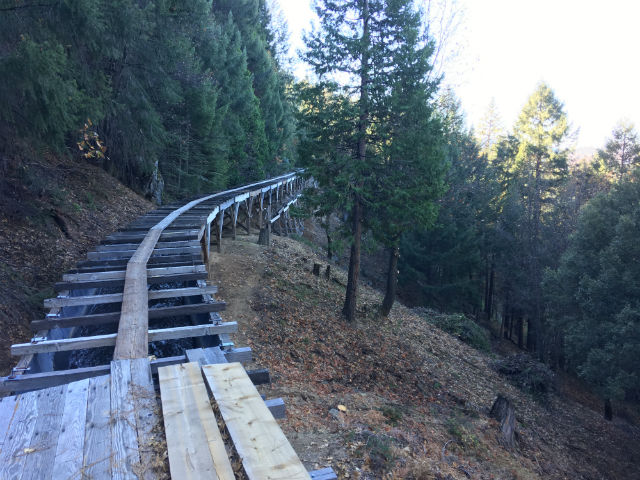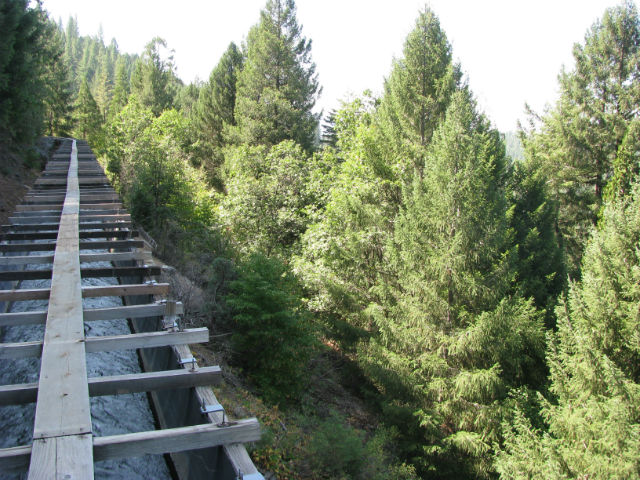Sonora, CA… In a joint collaborative partnership, Tuolumne Utilities District, as the project applicant, was awarded $496,000 yesterday (December 8th) in grant funding from the Sierra Nevada Conservancy (SNC) to implement a critical fuel break along the Tuolumne Main Canal which conveys water from Lyons Reservoir.
The Lyons-South Fork Watershed Forest Resiliency (LSFWFR) project is a collaborative effort to increase forest health, resiliency to wildfires and beetle outbreaks, and protect adjacent communities. This collaborative project will provide protection to critical sections of the South Fork (SF) Stanislaus
River and infrastructure that would benefit Tuolumne County and the ecoregion. The LSFWFR project area encompasses 733 acres of multiple-ownership forestland within the SF Stanislaus River watershed between Lyons Reservoir and the communities of Twain Harte and Mi-Wuk Village, covering a large swath of the southern canyon that spans 3,900 to 4,500 feet in elevation. In anticipation of a wildfire potentially jumping the river, the project’s eastern end includes the north side of the SF Stanislaus River below Lyons Reservoir to address the high fuel loading on these extremely steep slopes.
The main collaborative partners on this project are the Stanislaus National Forest, Pacific Gas and Electric Company (PG&E), Sierra Pacific Industries (SPI), Highway 108 FireSafe Council and Tuolumne Utilities District (TUD).
Thomas Haglund, General Manager for TUD stated, “Our Board of Directors identified fire protection for the water flume system as a high priority during a strategic planning and annual goal setting session in March. When the District looked at the grant application offered through the Sierra Nevada Conservancy’s Proposition 1 Watershed Improvement Program, we thought this would be an ideal opportunity to seek grant funding for a fuel break project along the Tuolumne Main Canal. The flume and ditch system originating at Lyons Reservoir are susceptible to wildfire. This grant will help to greatly reduce the threat of wildfire to this area. The District had many collaborative partners working on this grant application and we are thankful for their time, support and dedication to have this project recognized and funded by the SNC organization.”
The LSFWFR Project will help protect the PG&E’s Tuolumne Main Canal (TMC) a historic feature consisting of a series of wooden flumes and connected canals. It is the primary drinking water conveyance system for TUD and 90% of the residents of Tuolumne County. If a wildfire destroyed a section of the flume it is estimated that most of the residents of Tuolumne County would be without drinking water for more than a month. The TMC serves a residential population of approximately 44,000 in addition to commercial and industrial businesses. The primary private landowners SPI and PG&E are already working on removing dead and dying conifers and ladder fuels from their lands. The local Highway 108 Fire Safe Council is conducting projects on other privately owned land within and beyond the project boundary.
Mark Luster, Community Relations Manager for Sierra Pacific Industries, stated “The fuel reduction operation will result in biomass energy products and wood products for consumers as well as create jobs in the county which means positive economic benefits, while realizing the benefits and cost avoidance of another catastrophic wildfire.”
“Partnering on this important fuel reduction work is just one of the ways PG&E is committed to doing as much as possible to combat the bark beetle problem and vast tree mortality that is occurring throughout our service area. Over the past few years, we have provided significant funding to the Highway 108 Fire Safe Council, nearly $146,000 this year alone, to support fuel reduction and created an expanded debris removal program to help our customers reduce the impact this issue is having on them,” said Dave Meier, Senior Manager for PG&E’s Stockton and Yosemite divisions.
Estimated start date for the fuel break project is March 2017 with the main goal to reduce surface, ladder and canopy fuels on the Stanislaus National Forest Service lands in conjunction with adjacent landowners to reduce fuels across multiple land ownerships. Fuels reduction will create a continuous fuel break that protects the primary water conveyance system to Tuolumne County (i.e., the TMC), adjacent communities, and the overall resiliency of the SF Stanislaus River watershed.
“We are very happy to see the success of collaborative partnerships in action. We appreciate all the organizations that helped make this SNC grant submission a success,” said Scott Tangenberg, Stanislaus National Forest Supervisor. “This is another shining example of the commitment to improve ecosystem resiliency in the protection of our public lands and water sources.”
Key collaborative partners of the project:
– Tuolumne Utilities District (Fiscal Agent for project)
– Highway 108 FireSafe Council (Administrator of project work)
– USFS: Stanislaus National Forest (Receiver of grant funding; responsible for NEPA documentation;
Letter of Intent for Plan)
– Sierra Pacific Industries (Collaborating landowner)
– Pacific Gas & Electric Company (Collaborating landowner)
– California Reforestation Inc. (Consultant)
– Debbie Colston, Grant Writer, Etc. (Consultant)
– Twain Harte Community Services District (Project supporter)
– Tuolumne County (Project supporter)
– Tuolumne-Calaveras Unit of CalFire (Project supporter)
– California Conservation Corps (Project supporter)
The vulnerability of Tuolumne County’s water supply and forest ecosystems has been an issue of frequent study and discussion. In an effort to assess the consequences should the TMC be damaged or destroyed by a catastrophic event, TUD developed the South Fork Stanislaus Water Supply Reliability Project. In March 2008, TUD started work on this project, funded by a Proposition 50 grant to address vulnerable infrastructure throughout the State. The project was completed in several phases and was a successful collaboration with the County of Tuolumne, the USFS Stanislaus National Forest, the Highway 108 FireSafe Council, SPI, and Stantec Consulting.




